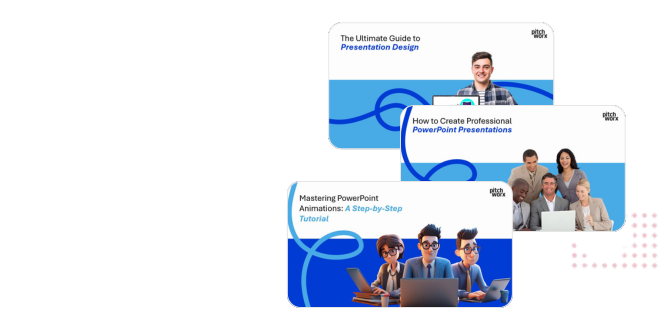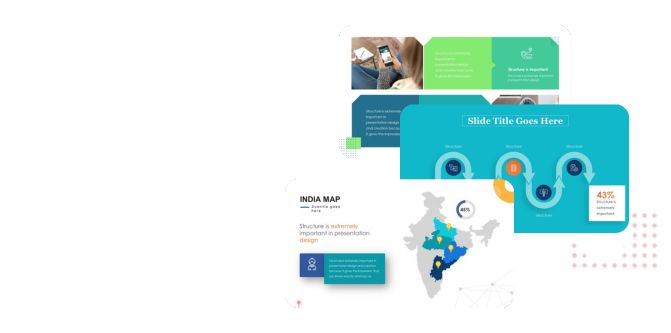Did you know that investors spend an average of just 2 minutes and 41 seconds reviewing a pitch deck? Even more surprising, 90% of them make their initial investment decision in the first 3 slides.
These statistics highlight why pitch deck design matters more than ever in 2025. Whether you’re a startup founder seeking seed funding or an established company planning your Series B, your presentation needs to capture attention instantly and maintain it throughout.
The challenge isn’t just about having a great business idea – it’s about communicating that idea effectively. In fact, many promising startups fail to secure funding simply because their pitch decks don’t convey their potential clearly enough.
This comprehensive guide will show you how to create a pitch deck that stands out, tells your story effectively, and convinces investors to take action. From understanding investor psychology to mastering visual design principles, we’ll cover everything you need to know about crafting a winning investor presentation.
Ready to transform your pitch deck from good to unforgettable? Let’s dive in.
Understanding Investor Psychology
Behind every investment decision lies a complex psychological process that few entrepreneurs fully understand. Venture capitalists don’t just evaluate your business proposition—they process your pitch deck through a series of mental filters that determine whether your startup gets funded or forgotten.
How investors scan pitch decks
Contrary to popular belief, investors rarely read pitch decks from start to finish. Instead, they follow what experts call the “3-30-3 rule” when evaluating presentations. This means they take 3 seconds for an initial glance, 30 seconds for a quick skim, and if those stages are passed, perhaps 3 minutes for a deeper dive. A typical investor receives approximately 5,000 pitches annually, reads about 600-800 of them, and may fund just two startups—or none at all.
When scanning your deck, investors mentally tick off items from their checklist, looking for clear problem-solution frameworks, market opportunity, business model viability, traction evidence, and team credentials. Rather than reading linearly, they flip back and forth through slides, focusing on visuals and headlines. This scanning behavior means your slides must be immediately digestible, with clear headlines and impactful visuals that communicate key points at a glance.
The 7-second rule of first impressions
Scientific research confirms that humans form judgments within the first 7 seconds of an encounter. For pitch decks, this window is even narrower—investors often make initial judgments in mere milliseconds, and these first impressions are remarkably difficult to change.
Your cover slide and opening content carry disproportionate weight in shaping how investors perceive your entire presentation. Like it or not, they immediately catalog your pitch as either interesting, credible, and promising, or boring, untrustworthy, and forgettable. Once negatively labeled, it becomes exceedingly difficult to change that perception.
The design quality of your pitch deck also sends powerful subconscious signals. Professional, clean layouts suggest competence and attention to detail, while inconsistent fonts or cluttered slides may introduce subtle doubts about your capabilities.
Decision triggers that prompt investment interest
Understanding the psychological triggers that drive investor decisions can dramatically improve your pitch deck’s effectiveness. Investors subconsciously evaluate startups using what industry experts call the “four Cs”: Competence (skill set to build the business), Continuity (commitment to see it through), Connections (networks to leverage), and Chemistry (team dynamics and investor fit).
Although investors present themselves as purely rational, research shows their subconscious plays a dominant role in decision-making. They rely heavily on:
- Pattern recognition: Matching your pitch against mental templates of past successes
- Loss aversion: Paying more attention to potential problems than opportunities
- Social proof: Looking for validation from other respected sources
- Emotional response: Making decisions with both head and heart
Investors aren’t just funding your business—they’re buying into a vision of the future. Your pitch deck’s ability to trigger positive psychological responses often determines whether you secure funding. By understanding these psychological principles, you can design presentations that speak directly to investors’ decision-making processes rather than merely presenting facts and figures.
Essential Elements of a Winning Pitch Deck
Creating a persuasive pitch deck requires more than just stunning visuals—it demands strategic content that speaks directly to investor concerns. The most effective pitch decks follow a proven structure that addresses four critical elements investors consistently evaluate before making funding decisions.
Problem-solution framework
The foundation of any compelling pitch deck begins with a clear problem-solution framework. This framework creates tension—a crucial narrative element that evokes an emotional response from investors. Your problem statement must be specific, personal, and focused on the biggest pain point experienced by your target market.
When presenting the problem, avoid vague generalizations. Instead, be frank about the consequences if the problem remains unsolved. This approach creates empathy for customers and establishes urgency in investors’ minds. Subsequently, introduce your solution as the logical resolution to this tension.
Successful problem slides often incorporate:
- Facts and statistics highlighting the problem’s scale
- User insights or case studies showing real-world impact
- Explanations of why existing solutions fall short
Remember that your solution should demonstrate a deep understanding of the situation while addressing pain points in a unique and innovative way. Keep this section concise—aim to communicate the problem-solution narrative within two slides maximum.
Market opportunity slides
After establishing the problem-solution framework, demonstrate the market potential for your offering. This section should clearly define your target market size and customer segments so investors can understand your strategy.
A comprehensive market opportunity slide typically includes:
- Total Addressable Market (TAM): The total revenue opportunity if you achieved 100% market share
- Serviceable Addressable Market (SAM): The specific portion of TAM targeted by your product
- Serviceable Obtainable Market (SOM): The realistic market share you can capture
For instance, a company targeting remote workers might show a TAM of 12 million people nationwide, a SAM of 750,000 in specific metro areas, and an SOM of 107,000 based on adoption patterns. Visually representing these metrics through graphs or charts makes the information more digestible for investors scanning your deck.
Traction and validation proof
Perhaps the most powerful element in your pitch deck is evidence that your concept works. The traction slide provides tangible proof of your startup’s momentum and validates your business idea. According to investment experts, this slide can significantly influence funding decisions since it signals reduced risk and greater potential for scaling.
For revenue-generating startups, showcase key metrics such as:
- Month-over-month growth
- Annual recurring revenue (ARR)
- Customer acquisition costs (CAC)
Pre-revenue startups should focus on alternative indicators like user engagement, downloads, partnerships, or testimonials. Essentially, your traction slide must communicate two critical ideas: that your startup is progressing rapidly and now is the optimal time for investment.
Team credentials that build trust
Every business relationship is founded on people, and investors need confidence that your team has the skills and experience to execute effectively. DocSend research found that investors spend approximately 15% of their total time reviewing pitch decks focused on the team slide alone.
This section should highlight:
- Relevant expertise and past successes of key team members
- Industry experience and technical skills of the core team
- Management capabilities and time commitment of founders
For maximum impact, limit this slide to three to five people, focusing on founders and key executives Include short, powerful bios (3-4 sentences) that emphasize relevant accomplishments rather than comprehensive life stories.
By thoughtfully crafting these four essential elements in your pitch deck design, you significantly increase your chances of capturing investor interest and moving to the next stage of funding conversations.
Visual Design Principles That Capture Attention
The visual design of your pitch deck communicates volumes before a single word is read. Research shows people make subconscious judgments about presentations within 90 seconds, and up to 90% of that assessment is based on color alone. With investors typically spending less than three minutes reviewing your entire deck, thoughtful design becomes crucial for making those moments count.
Color psychology for investor presentations
Colors aren’t merely decorative—they’re strategic tools that trigger specific emotional and cognitive responses in investors. Each funding stage benefits from different color approaches:
- Early-stage funding: Predominantly blue-based schemes establish credibility and trust, with small touches of vibrant colors to highlight key metrics
- Growth-stage funding: More dynamic palettes featuring greens to represent expansion and traction
- Late-stage funding: Deep, rich colors like burgundy, navy, and purple that convey market leadership and sophistication
The strategic application of color goes beyond esthetics—it directly impacts financial decisions. Reports with thoughtful color use can increase revenue by 1% and improve stock valuations by up to 70%. Furthermore, accessibility matters—ensure your color schemes remain readable for everyone by maintaining contrast ratios of at least 4.5:1 for text elements.
Typography hierarchy that guides the eye
Typography serves as a critical communication tool in pitch decks, influencing both readability and perception. Successful investor presentations typically employ:
- A clean sans-serif font for body text (Open Sans, Roboto, Helvetica, or Arial)
- Distinct font weights to establish visual hierarchy
- Limited font pairing—one font for headings and another complementary font for body text
Typography creates a roadmap for investors scanning your deck. The strategic arrangement of text guides attention to key information through size, weight, and spacing variations. Notably, every typographic element plays a specific role: serif fonts appear formal and traditional, whereas sans-serif fonts feel modern and approachable.
White space utilization for clarity
White space (negative space) isn’t empty space—it’s an active design element that dramatically enhances comprehension and impact. Proper utilization of white space:
- Creates visual hierarchy that guides investors through information in order of importance
- Groups related elements to signal their connection visually
- Allows key points to stand out through isolation
A powerful rule for pitch deck design is the 2/3 rule: aim to leave approximately 2/3 of your slide as white space, using the remaining 1/3 for content. This ratio prevents overcrowding and allows your key messages to breathe. Additionally, establish consistent margins and gutters on all slides—at least 0.5 inches, though 0.75 inches offers a more modern, professional look.
Cognitive Load Theory supports that more slides with ample white space are more effective than fewer, denser slides. This approach reduces mental strain during presentations, keeping investors engaged rather than overwhelmed by visual complexity.
Data Visualization Techniques That Persuade
Data visualization serves as the bridge between complex metrics and investor comprehension in pitch decks. Studies show that humans process visuals 60,000 times faster than text, making effective data visualization a critical component of persuasive presentations.
Simplifying complex metrics
The art of simplifying complex data begins with identifying the story your numbers tell. Rather than overwhelming investors with spreadsheets, translate key metrics into visual narratives that highlight patterns and opportunities. The “Green, Yellow, Red” framework offers an elegant solution for metric simplification. This color-coded approach instantly communicates what’s working (green), what needs attention (yellow), and what requires immediate action (red), allowing investors to grasp your business health at a glance.
When designing metric slides, focus on clarity over comprehensiveness. Remember that investors typically spend less than four minutes viewing a pitch deck, making simplicity paramount.
Comparative charts that show growth potential
Comparative visualizations powerfully demonstrate your startup’s growth trajectory. Select chart types based on the specific comparison you’re highlighting:
- Bar charts: Ideal for comparing different groups or market segments
- Line graphs: Best for illustrating trends and growth over time
- Waterfall charts: Perfect for showing performance changes across periods
Match your chart type to your data story—bar charts effectively showcase market opportunity versus competitors, whereas line graphs excel at projecting revenue growth. This strategic visualization approach transforms raw numbers into compelling evidence of your business potential.
Visual metaphors that stick in memory
Visual metaphors function as storytelling shortcuts that connect abstract concepts with familiar imagery. They condense paragraphs of explanation into single, memorable visuals that resonate emotionally with investors.
Effective pitch deck metaphors tap into shared experiences. For instance, comparing your startup journey to climbing a mountain instantly communicates the challenges overcome and heights achieved. These metaphorical frameworks aren’t merely decorative—they’re persuasive tools that make your message stick long after your presentation ends.
Indeed, properly designed data visualizations transform your pitch deck from information-heavy to insight-rich, dramatically improving your chances of securing investment.
Storytelling Frameworks That Drive Investment
Storytelling transforms ordinary pitch decks into powerful investment magnets. In fact, narrative-driven messages are 22 times more memorable than presentations focused solely on facts and figures. The most successful founders know that investors don’t just fund businesses—they invest in stories they can believe in.
The hero’s journey applied to startups
The hero’s journey, a universal storytelling structure popularized by Joseph Campbell, provides a perfect framework for startup pitch decks. This classic formula positions your startup as the protagonist embarking on a transformative quest. In practical application, your pitch deck should structure this journey in three key phases:
- The Departure (Problem) – Establish the problem your startup addresses, creating the call to adventure
- The Initiation (Solution) – Present your innovative solution as the hero’s transformation
- The Return (Vision) – Share your future vision where both investors and customers triumph
Importantly, in many effective pitch decks, the investor—not the startup—serves as the ultimate hero of this journey.
Building narrative tension and resolution
Creating pitch deck tension before revealing your solution dramatically increases investor engagement. Begin by vividly describing your target customer’s pain points, using sensory words that make the problem tangible and emotionally resonant. This narrative tension holds investors’ attention and creates anticipation for your solution.
For maximum impact, acknowledge potential obstacles and challenges openly. By addressing risks directly and showing your mitigation plans, you demonstrate resilience and adaptability—qualities highly valued by investors.
Creating memorable moments in your presentation
The most effective pitch decks contain what investors call “golden nuggets”—memorable moments that stick long after the presentation ends. These elements might include your founder’s origin story, particularly if it features an authentic “eureka moment” that sparked your innovation.
Research confirms that investors connect more deeply with pitches that begin with a personal story. For instance, one medical device startup’s pitch became memorable by sharing how its founder conceived the product idea during a bicycle ride while reflecting on his cancer patients’ struggles.
Finally, consider incorporating social good elements that align with your business model. This approach not only makes your presentation more memorable but may also open doors to different types of investors who value both profit and purpose.
Conclusion
Pitch deck design stands as a critical factor in securing investor funding, especially given the brief window of opportunity to capture attention. Successful pitch decks blend psychological understanding, strategic content structure, and compelling visual elements to tell a memorable story.
Remember that investors make quick decisions based on first impressions, typically within the first three slides. Therefore, your pitch deck must immediately demonstrate clarity through professional design, strategic use of white space, and simplified data visualizations that highlight your startup’s potential.
Most importantly, wrap your business proposition in a compelling narrative framework. Statistics show that story-driven presentations prove 22 times more memorable than fact-based presentations alone. This combination of strong visuals, clear metrics, and engaging storytelling creates a pitch deck that resonates with investors long after the initial review.
The path to funding requires both technical excellence and emotional connection. Focus on crafting a presentation that not only showcases your business potential but also builds trust through thoughtful design choices and authentic storytelling. Through careful attention to these elements, your pitch deck will stand out among thousands of others and effectively communicate your startup’s value proposition.
FAQs
1. How much time do investors typically spend reviewing a pitch deck? Investors make quick decisions based on first impressions, typically within the first three slides. According to recent feedback from pitch deck consulting services, investors spend as few as 7 seconds on a presentation to decide whether it’s worth their attention and potential funding.
2. What visual elements are most important in a pitch deck design? Professional design, strategic use of white space, and simplified data visualizations are crucial. High-quality, crisp images and appropriate color psychology also play significant roles in capturing investor attention and conveying your message effectively.
3. Why is storytelling so important in a pitch deck? Statistics show that story-driven presentations are 22 times more memorable than fact-based presentations alone. Investors connect more deeply with pitches that begin with a personal story, especially when they include authentic “eureka moments” that sparked your innovation.
4. How can I make my pitch deck stand out among thousands of others? Focus on crafting a presentation that builds trust through thoughtful design choices and authentic storytelling. Use color psychology strategically, incorporate clear data visualization, and ensure your narrative framework highlights both your business potential and the problem you’re solving.
5. Should I hire a specialist to help with my pitch deck design? Professional pitch specialists understand how to craft compelling narratives, present data effectively, and tailor presentations for different types of investors. They can significantly increase your success rates by ensuring your pitch meets the highest standards while allowing you to focus on your core business operations.










